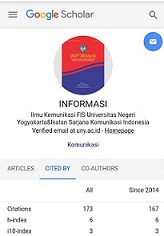THE LANGUAGE USE OF SEX ARTICLES IN WOMEN LIFESTYLE MAGAZINE IN INDONESIA CASE STUDY: COSMOPOLITAN INDONESIA
DOI:
https://doi.org/10.21831/informasi.v49i1.24505Keywords:
Sex, Indonesian Women, Women Magazine, Lifestyle, Cosmopolitan Indonesia,Abstract
The choice of words is one of important aspects in writing articles in printed media. Creative language use in lifestyle magazine may create interest for readers. The purpose of this research is to analyze the language use in sex articles in Cosmopolitan Indonesia. Launched in 1997, Cosmopolitan Indonesia is the first licensed Indonesian women lifestyle magazine and the first women magazine in Indonesia that openly discusses sex. This marks a change in Indonesian printed media. Before the publication of Cosmopolitan, sex and intimacy were only discussed in non-public spheres. Although the topics are discussed openly, the magazine uses special terms to describe man and women genital organs. After 22 years, Cosmopolitan Indonesia is still using the same terms in its sex articles, despite the fact that other women magazines are now discussing sex more openly and most of them are using the medical terms to describe genital organs. The focus of this research is mainly on what factors that consider Cosmopolitan Indonesia to use special terms in sex articles. The methodology will include purposive sampling interview and content analysis of 6 editions of Cosmopolitan Indonesia. The findings of this research may help the media and journalists to be more creative in choosing words for particular articles to attract readers interest, also to established the media unique identity, especially for lifestyle magazine.
Pemilihan kata-kata adalah aspek penting dalam penulisan artikel dalam media cetak. Bahasa yang kreatif digunakan dalam penulisan untuk majalah gaya hidup agar menarik perhatian pembaca. Tujuan dari penelitian ini adalah untuk menganalisis penggunaan Bahasa pada majalah Cosmopolitan Indonesia. Diterbitkan tahun 1997, Cosmopolitan Indonesia adalah majalah gaya hidup berlisensi Internasional untuk perempuan pertama dan majalah perempuan pertama di Indonesia yang mendiskusikan topik seks secara terbuka. Hal ini menandai perubahan pada sejarah media cetak di Indonesia. Sebelum terbitnya majalah Cosmopolitan Indonesia, seks dan hubungan intim umumnya tidak didiskusikan secara terbuka pada media cetak. Walaupun topik-topik didiskusikan secara terbuka, majalah ini tetap menggunakan istilah tersendiri untuk menggambarkan alat kelamin lelaki dan perempuan. Setelah 22 tahun, Cosmopolitan Indonesia tetap menggunakan istilah istimewa untuk artikel seks, walaupun majalah perempuan lainnya kita telah membicarakan seks dengan lebih terbuta dan umumnya menggunakan istilah medis untuk menggambarkan alat kelamin. Fokus dari riset ini adalah untuk mengetahui faktor apa saja yang membuat Cosmopolitan Indonesia mempertimbankan untuk memilih istilah khusus dalam penulisan artikel seks. Metodologi yang digunakan adalah purposive sampling interview dan content analysis dari 6 edisi Cosmopolitan Indonesia. Penemuan hasil riset ini diharapkan dapat membantu media dan jurnalis untuk lebih kreatif dalam memilih kata-kata untuk beberapa artikel spesifik untuk menarik perhatian pembaca, juga membentuk identitas unik sebuah media, khususnya majalah gaya hidup.
References
Attwood, F, Barker, M, Boynton, P, & Hancock, J. Sense about Sex: Media, Sex Advice, Education and Learning, 528-539 https://doi.org/10.1080/146818 11.2015.1057635
Barlow, Kara W. "Cosmopolitan Goes Intercultural: A Semiotic Analysis of Cosmopolitan Magazine Covers" (2016). Linfield College Student Symposium: A Celebration of Scholarship and Creative Achievement. https://digitalcommons.linfield.edu/ symposium/2016/all/28
Cosmopolitan. (2017). Fun Fearless Female Magazine, http://www.mra.co.id/ index.php?option=com_content&view =article&id=50&Itemid=65, Accessed 14 April 2019.
Hermes, J. (1995). Reading Women's Magazine, Polity Press, London.
Krippendorff, K. (2018). Content Analysis: An Introduction to Its Methodology, Sage Publication, London.
Etikan, I, Musa, S, & Alkassim, R. Comparison of Convenience Sampling and Purposive Sampling. American Journal of Theoretical and Applied Statistics. Vol. 5, No. 1, 2016, pp. 1-4. doi: 10.11648/j. ajtas.20160501.11
Kim, J & Ward, M (2012) Striving for Pleasure Without Fear: Short-Term Effects of Reading a Women's Magazine on Women's Sexual Attitudes. https://doi. org/10.1177/0361684312442856
Machin, D., & van Leeuwen, T. (2005). Language style and lifestyle: the case of a global magazine. Media, Culture & Society, 27(4), 577–600. https://doi. org/10.1177/0163443705054151
McCracken, E. (1993). Decoding Women's Magazines, The Macmillan Press Ltd, London.
McRobbie, A. (1991). Feminism and Youth Culture From "˜Jackie & Seventeen', Macmillan, London.
Nederstigt, U & Hilberink-Schulpen, B. (2017). Just Advertising in a Foreign Language or the Consumers' Native Language? Journal of International Consumer Marketing, 2-13. https://doi. org/10.1080/08961530.2017.1363008
Pape, S., & Featherstone, S. (2006). Feature Writing: A Practical Introduction, Sage Publication, London.
Tomlinson, J. (1999). Globalization and Culture, Polity Press, Cambridge.
Weibel, K. (1977). Mirror Mirror: Images of Women in Popular Culture, Anchor Press, New York.
Weber, R. (1990). Basic Content Analysis, Sage Publications London.
Weeler, S. (2009). Feature Writing for Journalists, Routledge, London and New York.
Winship, J. (1987). Inside Women's Magazine, Pandora, London.
Ytre-Arne, B. (2011). Women's magazines and their readers: The relationship between textual features and practices of reading. European Journal of Cultural Studies, 14(2), 213-228. https://doi. org/10.1177/1367549410389928
Downloads
Published
How to Cite
Issue
Section
Citation Check
License
Authors who publish with this journal agree to the following terms:- Authors retain copyright and grant the journal right of first publication with the work simultaneously licensed under a Creative Commons Attribution License that allows others to share the work with an acknowledgement of the work's authorship and initial publication in this journal.
- Authors are able to enter into separate, additional contractual arrangements for the non-exclusive distribution of the journal's published version of the work (e.g., post it to an institutional repository or publish it in a book), with an acknowledgement of its initial publication in this journal.
- Authors are permitted and encouraged to post their work online (e.g., in institutional repositories or on their website) prior to and during the submission process, as it can lead to productive exchanges, as well as earlier and greater citation of published work (See The Effect of Open Access).
























